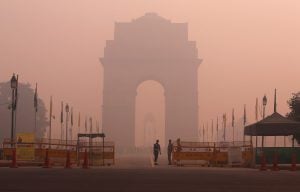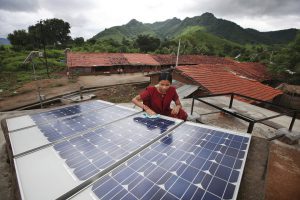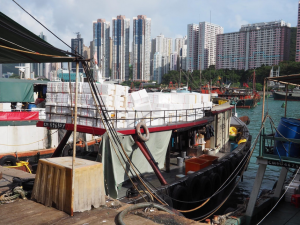In September, the World Bank reportedly approved a USD 120 million (INR 7.8 billion) loan to the state of Assam for the development of inland water transport. Coming closely on the heels of an earlier USD 368 million (INR 24 billion) loan from the bank in April 2017 for the Ganga national waterways, this indicates the importance the Indian government attaches to the push for inland waterways.
An ambitious programme
The intent of the government was clear when it enacted the 2016 National Waterways Act, which declared 111 rivers or river stretches, creeks, estuaries as national waterways. Prior to this act, there were only five, including National Waterway 1 on the Ganga from Haldia to Allahabad, and National Waterway 2 on the Brahmaputra.
Read: Water based transport: perils and possibilities
The Indian government has made a strong push for these five waterways and recently announced work on another 10. The plans are to develop these waterways into commercial shipping and navigation systems for the movement of large cargo and passenger vessels. In August, Nitin Gadkari, the minister for shipping, said: “Inland waterways are a game changer. They are going to reduce logistics costs which will help industry export promotion and create more employment.”
But this statement projects a rather optimistic view of the waterways.
Advantages are conditional
It is true that waterways can offer several advantages. The most important is that they are fuel-efficient compared to other modes of transport, namely rail and road. Waterways are said to be cheap, environmentally friendly, and can help connect remote areas – especially in the north-eastern states. But these advantages are neither unqualified, nor automatic. They will manifest only when certain conditions are met, and only under certain circumstances. For example, the difference in fuel efficiency is not so high if the comparison is with railways. Waterways can be more costly and cumbersome if door-to-door delivery is needed. Thus, the viability and desirability of waterways would need to be decided on a case by case basis.
At the same time, creating and maintaining waterways needs a huge intervention in rivers, with serious impacts. Unfortunately, as in much other infrastructure development, these impacts are being ignored.
The most important need for a waterway is to ensure a channel of depth of two to three metres with widths of 45 to 60 metres. This is done through several means; constructing barrages to raise water levels, river straightening to remove bends, bank protection works and, most importantly, dredging. As can be imagined, these interventions would have a huge impact on the river morphology, hydrology and, in turn, the ecology and habitats it sustains. It also has severe implications for the communities depending on the river and its fish.
Along with the channel comes related infrastructure such as river ports, material handling sites, storage godowns, barge maintenance, repairing centres and refuelling points. Unfortunately, the impact of all these is not properly assessed or incorporated into project designs.
Environmental clearances – confusion and free for all
The environmental assessment and clearance process is governed by the EIA Notification 2006, which does not mention waterways in its list of projects needing environmental clearance. It does, however, include “ports, harbours, breakwaters, dredging,” meaning that environmental clearance should be mandatory for every waterway.
But in an October 2016 affidavit, related to National Waterway 1, the ministry of environment, forests and climate change (MoEFCC ) states that jettys, multimodal terminals and inland waterways are not covered under the notification. To add to the confusion, the MoEFCC had earlier initiated the environmental clearance process for National Waterway 4 (traversing Andhra Pradesh and Tamil Nadu) as well as national waterways 27, 68, 111 in Goa.
Subsequently, in a letter dated 19 June 2017, the MoEFCC told the Inland Waterways Authority of India (IWAI) that the Ganga waterway is covered by the EIA Notification and will need environmental clearance. But the letter, obtained under the Right to Information Act, has not been placed in front of the National Green Tribunal by the MoEFCC. Publicly, the MoEFCC has allowed the ambiguity about the applicability of environmental clearance to waterways persist.
As a result, work that could have major impacts is proceeding without any proper regulation. For example, Gadkari is planning to inaugurate dredging work on the Barak river (National Waterway 16) on 18 November 2017 during the three-day Namami Barak festival. No environmental clearance has been sought or given for the project.
Implications
The implications of proceeding without proper environmental assessments can be gauged from a couple of instances related to the Ganga waterway. There are several protected areas in the path of the waterway – one is the Kashi Turtle Sanctuary. The waterway has to get clearance from the National Board for Wildlife (NBWL) under the Wildlife Protection Act to go through this sanctuary. The expert committee examining the impact of the waterway on the turtle sanctuary has assessed that the operation of the waterways would have massive impacts and has implemented several conditions when giving the waterway clearance. One of these is that a maximum of five barges is allowed to move through the sanctuary per day.
However, the project had been planned with around 30 barges moving through it per day. If the total movement is cut down to less than 16% of the planned frequency, what will be the impact on the viability of the waterway? Such questions can be conveniently brushed aside because the wildlife impact assessment has been totally disconnected with the project planning. It is most likely that either this condition will be blatantly violated, or the sanctuary may be de-notified.
It is also important to understand that sanctuaries may be especially important, but actually entire rivers are home to fish, flora and fauna. These too would be affected by the waterway.
In 2016, the expert appraisal committee of the MoEFCC asked the National Thermal Power Corporation, a major user of the Ganga waterway, to carry out an impact assessment study of coal transportation on the waterway. Conducted by ICAR-Central Inland Fisheries Research Institute (CIFRI) in Kolkata, the study focused on a stretch from Haldia port to Farakka through the Hoogly river. The report strongly corroborates the severe impacts, noting the sharp fall in fish diversity due to barge movement and the fall in income of the 25,000 fisherpeople dependent on it.
These are only a few examples. My study of waterways indicated severe, wide-spread and extensive impacts of the waterways on rivers, river ecology and the livelihoods of communities dependent on them. At the same time, the legal and regulatory mechanism to assess and address these impacts is, at best, weak and ambiguous and, at worst, absent. This needs to be addressed immediately. Otherwise, the waterways are likely to turn out to be a pyrrhic victory of sorts.
We want to hear from you! Tell us what you think about The Third Pole and you could win $100. Take our survey here.
![<p>Inland waterways could revolutionise trade in South Asia [image by fr4dd/Flickr]</p>](https://dialogue.earth/content/uploads/2016/09/water-transport.jpg)







